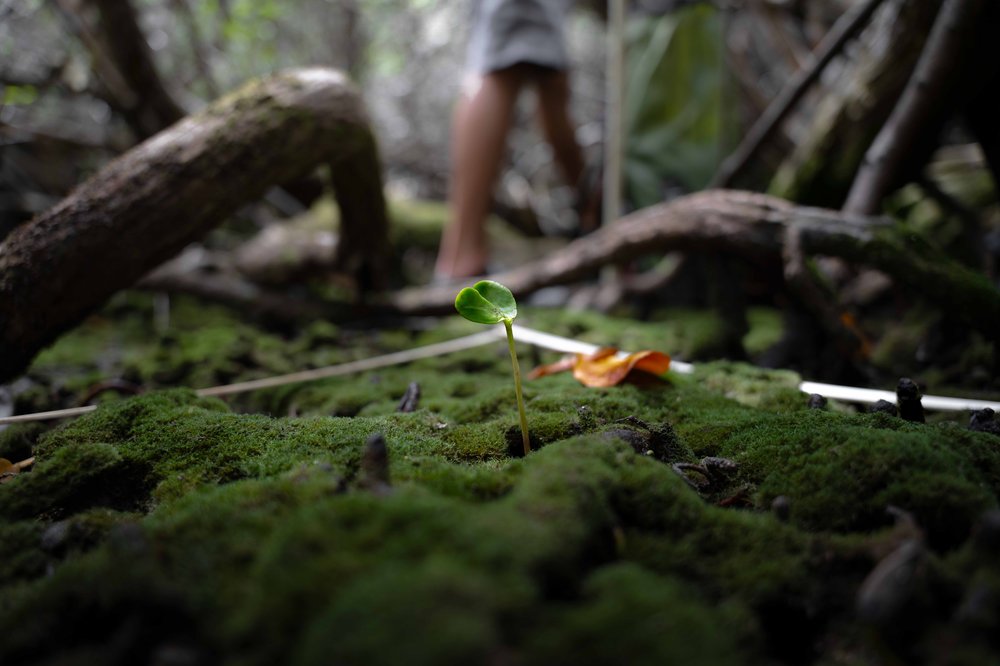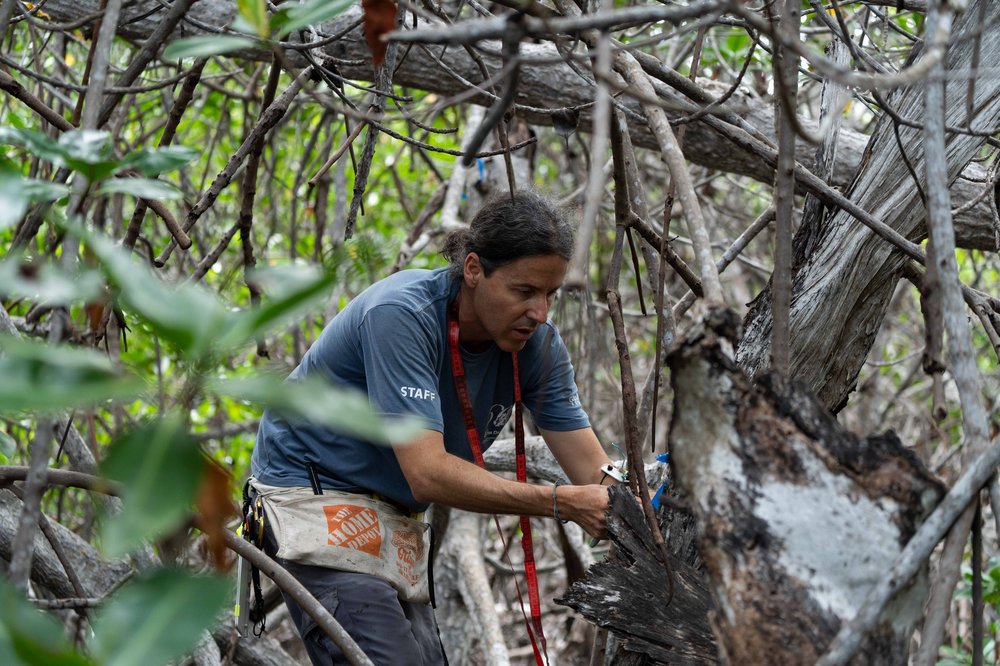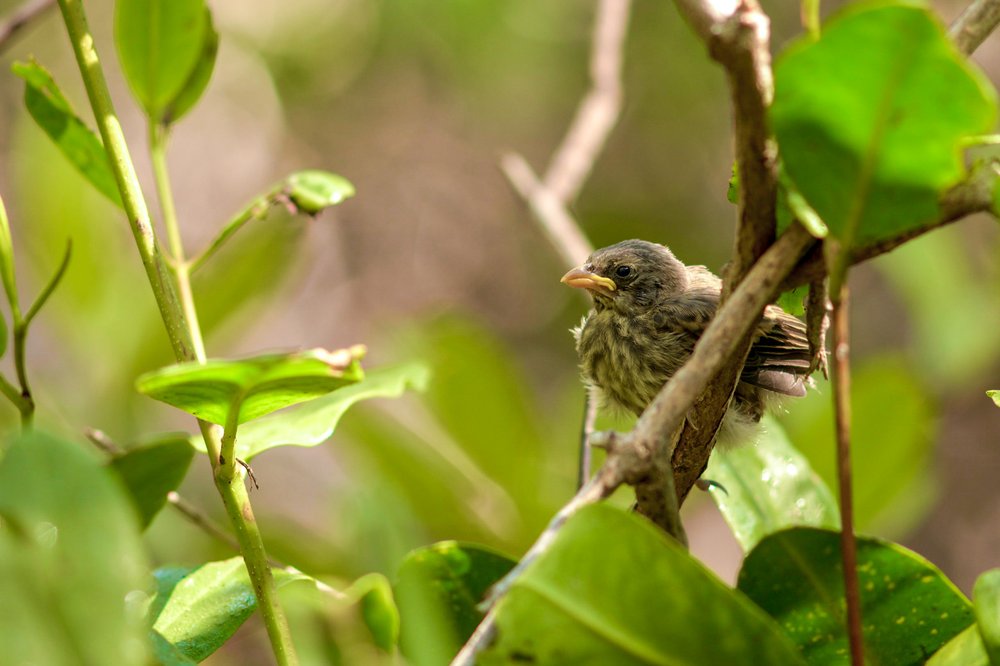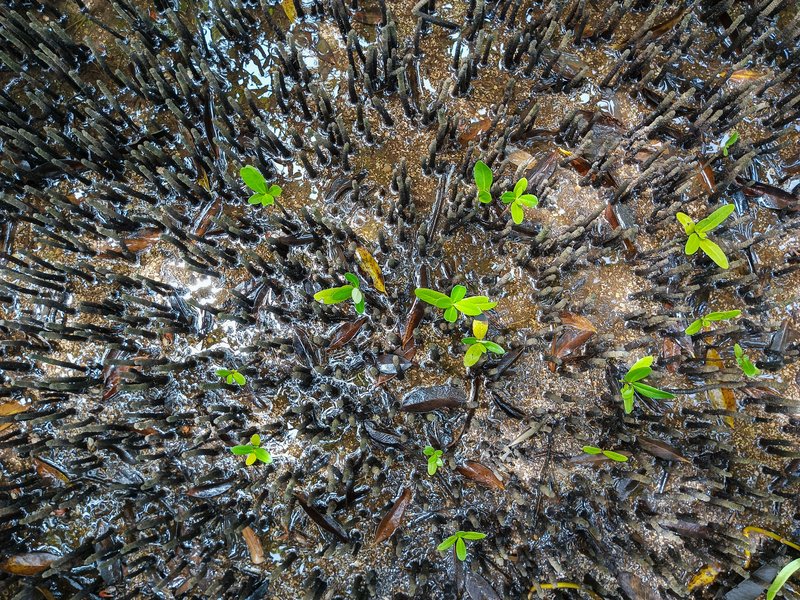First study classifies Galapagos Mangroves as Vulnerable
Puerto Ayora - Galapagos, December 11, 2024 – Scientists from the Charles Darwin Foundation (CDF) have, for the first time, assessed the conservation status of mangrove ecosystems in the Galapagos Islands using the Red List of Ecosystems methodology developed by the International Union for Conservation of Nature (IUCN). The study concludes that this ecosystem is classified as Vulnerable, underscoring the importance of its continued conservation. The full report is available in the EcoEvoRxiv repository.
Mangrove ecosystems play essential roles in maintaining biodiversity, mitigating climate change, and protecting coastlines against natural disasters. Unfortunately, their conservation status around the globe is precarious. Mangroves currently cover approximately 150,000 km² worldwide, primarily along tropical and subtropical coastlines.
To evaluate mangrove health, the IUCN conducted the first global assessment of mangroves using its Red List of Ecosystems methodology, including those in Galapagos. The study, which involved over 250 scientists from 44 countries, revealed that more than 50% of the world's mangroves are at risk of collapse. Major threats include deforestation, aquaculture, climate change, and rising sea levels. Without urgent conservation actions, these critical ecosystems could face significant degradation by 2050, with potentially severe ecological, social, and economic impacts.
Galapagos Mangroves: A Vital Refuge for Unique, At-Risk Species
Galapagos mangroves is one of 36 ‘ecoregions’ identified by the IUCN. Covering just 36.6 km², they account for just 0.03% of the global mangrove area. Despite their small size, these ecosystems are vital, providing habitats for numerous native and endemic species, serving as essential areas for living, feeding, reproducing, and sheltering from predators. Galapagos mangroves support at least 70 species listed on the IUCN Red List of Threatened Species, including sharks, rays, sea turtles, Galapagos penguins, and flightless cormorants. They are also home to the last remaining population of the critically endangered mangrove finch, estimated at only 100 individuals with fewer than 20 breeding pairs.
“Although they represent just a small fraction of the global mangrove area, Galapagos mangroves hold immense value as vital habitats for countless endangered species,” highlights Nicolas Moity, lead author of the assessment and principal investigator at the CDF.
In the Galapagos Islands, nearly all mangrove areas are within the Galapagos Marine Reserve, where destructive activities like shrimp aquaculture, responsible for a 40% loss of mangroves on mainland Ecuador over the past 40 years, are strictly prohibited. This is the first comprehensive evaluation of the threats faced by Galapagos mangroves, conducted with the participation of scientists from the Charles Darwin Foundation, IUCN specialists, and the Smithsonian Institution.



Understanding Threats to Better Protect Galapagos Mangroves
Although Galapagos mangroves were previously thought to face few threats because of their protected status and relatively intact condition, applying the IUCN RLE methodology revealed that Galapagos mangroves are classified as Vulnerable. Major threats identified in the study include volcanic eruptions, tsunamis, fires, and invasive species—events that have the potential to rapidly affect large areas of mangrove habitat and result in significant losses of ecological function.
For example, the 2018 Sierra Negra volcanic eruption resulted in the loss of approximately 18 hectares of mangroves in western Isabela. Similarly, the 2011 tsunami left a trail of dead mangroves along the coastline, affecting over 250 hectares of this precious ecosystem. These natural events, which occur approximately every two years in the Galapagos, are compounded by human-induced impacts such as pollution, fires, plastics, microplastics, hydrocarbons, boat damage, and urban expansion on inhabited islands. Despite their general protection within the archipelago, these findings highlight the considerable vulnerabilities of Galapagos mangroves.
“Establishing permanent monitoring sites on the islands, particularly in places like Isabela, is essential to better inform conservation and management measures,” explains Moity. “Following recent volcanic eruptions, we lack crucial information, such as which mangrove species were lost, the amount of carbon these ecosystems stored, and the species that depended on them. These data are vital for assessing the real impact of such disasters and developing effective mitigation measures.”
Mangroves and Climate Change
Pilot studies led by Moity indicate that Galapagos mangroves have the potential to store 1.8 million tons of blue carbon, significantly contributing to climate change mitigation. However, climate change itself poses complex challenges to these ecosystems. For example, future changes in precipitation patterns, sea temperature, ocean currents, and wind regimes could significantly alter the growth and health of mangroves. Under a projected sea-level rise of 1.1 meters by 2060 (IPCC RCP8.5 scenario), up to 25% of the current Galapagos mangroves could be submerged. This would not only compromise their blue carbon storage capacity but also threaten the survival of numerous species that rely on them, as well as the well-being of human communities living nearby.
“Identifying key mangrove areas that store the most carbon, host the greatest biodiversity, and provide the most ecosystem services is a top priority,” notes Moity. “Because different species depend on mangroves in varying ways, and mangrove development is highly variable, understanding which areas deliver the highest ecological function and ecosystem services will guide conservation efforts more effectively and with greater precision.”

For media enquiries, please contact:
Charles Darwin Foundation
Daniela Ibarra or Leslie León
comunicacion@fcdarwin.org.ec
About the Charles Darwin Foundation
The Charles Darwin Foundation for the Galapagos Islands (CDF) is an international non-profit organization that has been present in the Galapagos since 1959, operating under a special agreement with the Government of Ecuador. Its mission, along with that of its Scientific Station, is to address the greatest threats and challenges facing the Galapagos through scientific research and conservation actions, aiming to protect one of the world's most important natural treasures.
Currently, the CDF conducts more than 25 research and conservation projects and serves as the custodian of over 135,000 specimens in its Natural History Collections. Its diverse team of over 140 individuals is predominantly made up of Ecuadorian citizens, with more than 60% being residents of the Galapagos Islands.
For more information, visit: www.darwinfoundation.org




